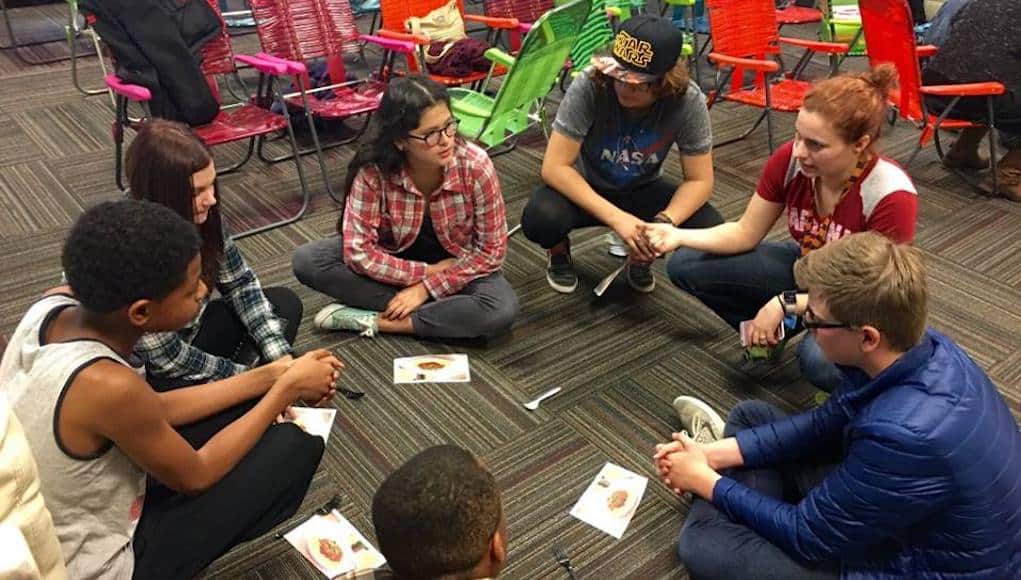Iteration in Action: Denver School of Innovation and Sustainable Design

By Springpoint Schools
On a typical day at the Denver School of Innovation and Sustainable Design (DSISD), groups of four or five students are reading different novels in ELA class. They discuss the characters and plots of their books, record standards-based observations and respond to questions on their Chromebooks. One group is predicting a protagonist’s next moves, and another is using context clues to infer the definitions of key words.
The curriculum, designed by English teacher Stephanie Price, allows students to move through the course in two distinct, yet intertwined, paths—some are in AP English and others are in Intro to Lit (the equivalent of a standard ninth-grade English curriculum). Students can opt into whichever path they want, and rather than being in the same path for an entire year, they have an opportunity to move between them at the beginning of each trimester. If a student wants more of a challenge or is improving quickly, they can opt into AP English after just a few months. To read more about Ms. Price’s classroom design, see here.
Student-Driven Design Decisions
When DSISD opened, it didn’t feature this kind of deeply integrated differentiation. Originally, students spent the majority of their time working individually to master online course material. The curriculum was mastery-based, but—according to students—it wasn’t engaging. Alex, a student who chose DSISD for its emphasis on student agency, thought there should be more time for direct instruction. So Alex, along with a few other student leaders, took action. As Alex describes it, they “held the principal captive” to discuss “how students are learning. Not necessarily what they were learning, but how.”
Principal Daniel Medved remembers the conversation differently. Because his team had designed a space for student leaders to share their feedback on the model, they were comfortable articulating their desire for more direct instruction. In response to their concerns, Medved adjusted DSISD’s model to support teachers in rewriting their lessons to incorporate more direct instruction alongside personalized projects. The shift gave students the tangible instructional benefits they asked for, but it also sent a powerful message: As one student said, “if you [have feedback] and you talk to Principal Medved about it, and it’s reasonable, then he will do everything he can” to make a change.
DSISD students feel that they’re part of a dynamic community that responds rapidly to their needs and gives them room to grow. According to another student, “I used to have the mindset that once I turned in a paper and got a grade, it was done. The greatest thing about this school is that you can always make yourself and the grade better.”
Systems to Support Mastery-Based Learning
DSISD opened as part of Opportunity by Design in partnership with Springpoint, and its design is informed by the 10 School Design Principles. The school has adapted Summit’s Personalized Learning Plan (PLP) platform, with its competency-aligned playlists, to enable a personalized, mastery-based approach. The adapted PLP houses all of DSISD’s teacher-designed projects and assessments, which are tagged to specific cognitive skills. These skills, like “selection of evidence” or “identifying patterns and relationships,” cut across subject areas. When they log into the system, each student can see exactly how they are progressing toward mastery of each skill.
Cognitive skills are a subset of DSISD’s competencies, which are posted in almost every hallway. The competencies are split into four categories: personal academic excellence, lifelong learning and citizenship, innovative thinking and action, and transformative leadership. The first category, academic excellence, comprises cognitive skills and content knowledge; the remaining categories are non-academic, or “soft” skills. On a recent visit, some students were completing questionnaires in Google docs to communicate mastery of non-academic competencies like personal health and “wayfinding,” or planning what comes next after high school.
Now in its second year, the Denver School of Innovation and Sustainable Design has made targeted adjustments to its instructional model to support the evolving needs of students. Teachers now plan at the yearlong level, repeating cognitive skill lessons at regular intervals. This allows students to build their mastery of key skills throughout the year, rather than at a single point in time. DSISD has also shifted its PD approach to be aligned with the Buck Institute’s project-based learning approach. Lastly, DSISD moved advisory to the middle of the day to accommodate students who arrive late—these are often the students who benefit from advisory time the most.
Student Agency and Ownership
Thoughtful instructional design aside, what stands out most about DSISD is the way students speak about their role in designing their school, the flexibility their school gives them to accelerate if they feel they’re ready, and the sense of camaraderie they feel toward one another. “The fact that we’re able to choose AP classes in 9th grade is amazing,” says one student. “They kind of let us bend the curriculum a little more,” another student says. “We can choose what to do now and what to do later, and the teachers will support us.”
As DSISD scales to full enrollment, it is considering the best ways to scale this level of student ownership, and ensuring students get credit for all the different kinds of work they do. Medved and his team are already considering ways to create student leadership teams to ensure the strong culture they’ve built continues through 12th grade. And each teacher, including Ms. Price, is planning for how they will embed competency-based learning even more deeply into their courses. Principal Medved has learned that it’s important to “consider the few things we want to be excellent at, and not try to be all things to all people. The more moving parts, the more room for error.”
“We feel like DSISD is our school. It’s the students’,” is how one student summarizes their sense of ownership. We’re excited to see how these student pioneers continue to shape the Denver School of Innovation and Sustainable Design as it grows and evolves.
For more, see:
- Innovative Urban Education in Denver
- Student Voices: Moving Beyond “When I Grow Up”
- Denver Public Schools Partners with KIPP Colorado for Student Success
This is the first in a series on iteration in school design originally published on springpointschools.org. See part two here.
Springpoint is a national organization that supports the design and launch of innovative secondary school models that connect young people to postsecondary success. Their mission is to enable all students, regardless of environment or background, to succeed in high school, college, and beyond. Follow them on twitter: @springpointEDU.
Stay in-the-know with all things EdTech and innovations in learning by signing up to receive the weekly Smart Update. This post includes mentions of a Getting Smart partner. For a full list of partners, affiliate organizations and all other disclosures, please see our Partner page.










0 Comments
Leave a Comment
Your email address will not be published. All fields are required.